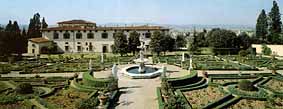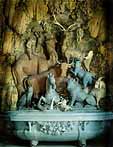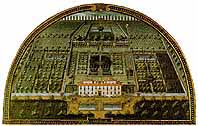
Front view
You can reach the Villa Reale, which takes its name from the area of Castello,
by walking the few hundred metres down the hill from Petraia and
taking Via di Castello.
Its name is apparently derived from a water reservoir ("castellum"
in Latin), that once formed part of the Roman aqueduct, later used
to supply the play of water and fountains in the park; it has
since been filled in to form the square in front of the villa.
The primitive 14th century building, known as the "Vivaio"
or Nursery, changed hands several times before it was eventually
bought by the cadet branch of the Medici
family;
Lorenzo "the Elder" (1395-1440), the younger brother of
Cosimo the Elder, was the head of this branch of the family. However
it was another Lorenzo, known as "the Younger", the son
of Pier Francesco and therefore the grandson of the founder of the
family, who bought the estate in 1477. Botticelli was to carry out
the famous masterpieces that are the pride of the Uffizi
Gallery today - the Primavera (1477-78) and the Birth of Venus
(1485 c.), which was conceived as a companion for the former - especially
for this villa and this member of the Medici family, the second cousin
of Lorenzo the Magnificent.
Only a few decades were to pass before the villa was sacked during the seige
of 1527; the Medici were thrown out of the
city and then returned to govern it, this time permanently. However they returned
with the last surviving member of the cadet branch, usually known as the Medici
family of Castello.
This was Duke Cosimo I, the son of Giovanni delle Bande Nere; he had grown up in the
villa of Castello, far from the political intrigues of the city and the rest
of the family, thanks to the foresight of his mother, Maria Salviati.

Pool by Ammannati
with
statues
by Giambologna
Cosimo was always particularly fond of the villa and commissioned Vasari to
restore and enlarge it. Tribolo, called
in especially from Bologna in 1537, was entrusted with the design of the
garden.
This was where the real fame of the Italian formal garden was born, long before
the magnificent gardens of Boboli and Petraia were
created, though it really ought to be called the garden of the Medici family.
Historian Benedetto Varchi created an iconographic programme that covered two
main themes: an allegorical portrayal of the life of nature and the glorification
of the Medici family, Florence and Tuscany. The entire
garden was created on terraces that followed the line of the hill, with grottos,
niches, nymphs, statues and fountains, together with unexpected jets of water
that would suddenly spray the heads or the legs of visitors.
The many fine garden ornaments include the lovely fountain of Hercules suffocating
Antaeus by Tribolo and Ammannati and a statue
of Winter (or the Appennine) carried out by Giambologna.
An artificial grotto, carried out in clear Mannerist style (1570 c.), still contains
a basin, shaped like a classical sarcophagus, that is attributed to Ammannati;
this is surmounted by a pyramid-shaped group of both exotic and ordinary
animals, that look as though they are escaping from the rock, carried
out by Giambologna and school in various types of stone and marble.
This ambitious project was to reveal Tribolo as a great hydraulic engineer for,
with the help of Piero di San Casciano, he even connected the villa up with the
waters from the nearby springs of Castellina and Petraia.
When Tribolo died (1550), his work was continued by Vasari and later by Buontalenti, who was anyway working
at Castello in around 1592 to restructure the villa; however the original
design of the garden was never completed: it was supposed to be decorated with
many more statues and fountains and have a wide driveway bordered by little canals
full of prawns and fish that would have been linked up directly with the Arno,
some distance away.

Villa di Castello by G.Utens
The famous Etruscan Chimera (today in the Archeological
Museum)) was kept for a while at the villa because it was believed
that it would bring bad luck if it were kept in Palazzo
Vecchio.
The sophisticated garden creates a charming contrast with the simple fifteenth
century style of the villa whose facade, although imposing in size, is carried
out on an almost austere architectural design, very different from the refined
style of the villa at Poggio a Caiano designed by Giuliano
da Sangallo for Lorenzo the Magnificent in 1485. The frescoes by Bronzino and Pontormo that once decorated it have since unfortunately
been lost. Ferdinando II commissioned Volterrano to
carry out the new decorations.
From the 15th century onwards, foreign visitors to the villa were to talk about
it with wonder (Montaigne and the botanist Pierre Belon, who wrote a descriptri.Cosimo
I's home on his retirement from public life. The prince lived here with his
second wife, Camilla Martelli, until his death in 1573.
This residence was always popular with the Medici court because of its proximity
to the city and the Lorraine family was to continue this tradition: Pietro Leopoldo
in fact had other decorations carried out there during his reign. The Savoy family
preferred Villa
Today the garden can be visited during the day, while, since 1965, the villa
has been the seat of the Crusca Academy, founded
for the study of the Italian language in 1582.
